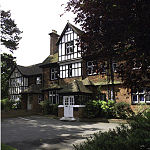Banstead railway station

Banstead railway station serves the village of Banstead in the borough of Reigate and Banstead in Surrey. Its wider definition of Banstead Village and Nork wards is relevant here as both are equally well served by it as it lies narrowly in the latter. The station and all trains are operated by Southern and it is on the Epsom Downs line, part of the Sutton & Mole Valley Line services. It is between Belmont and Epsom Downs, 17 miles 40 chains (17.50 miles, 28.16 km) down the line from London Bridge, measured via West Croydon.Housing and gardens in Banstead in this area border Greater London 500m away to the north. Accordingly, since January 2006, the station has been included in Travelcard Zone 6. The station lies some distance to the north-west of the High Street on the edge of Banstead Downs.
Excerpt from the Wikipedia article Banstead railway station (License: CC BY-SA 3.0, Authors, Images).Banstead railway station
Banstead Road, Reigate and Banstead Nork
Geographical coordinates (GPS) Address Nearby Places Show on map
Geographical coordinates (GPS)
| Latitude | Longitude |
|---|---|
| N 51.329194444444 ° | E -0.21319444444444 ° |
Address
Regal Cars
Banstead Road
SM7 1PZ Reigate and Banstead, Nork
England, United Kingdom
Open on Google Maps







